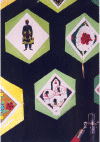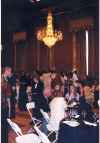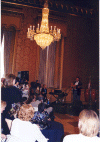Madagascar

Description:
Three pieces from a lamba, which is a large woven shawl,
form the backdrop for
the Madagascar block. The type
 of lamba and the manner in which it
is worn, by both men and women, depends on the occasion and the person’s
social position. In each oval, a beautifully embroidered portrait of a
woman is surrounded by colourfully stitched local vegetation. Women in
Madagascar love to do one another’s hair and the carefully reproduced
sampling of hairstyles in this piece reflect the distinctive styles of lamba and the manner in which it
is worn, by both men and women, depends on the occasion and the person’s
social position. In each oval, a beautifully embroidered portrait of a
woman is surrounded by colourfully stitched local vegetation. Women in
Madagascar love to do one another’s hair and the carefully reproduced
sampling of hairstyles in this piece reflect the distinctive styles specific to each geographical region. For the Malagasy, hair, embroidery
and lambas are all important aspects of daily living.
specific to each geographical region. For the Malagasy, hair, embroidery
and lambas are all important aspects of daily living.
History:
Located off the east coast of Africa and known as the ‘Great
Red
Island’ to its neighboursbecause of the colour of the soil, Madagascar is
the world’s fourth largest island. It is home to many unique plants and
animals, half of all chameleons in the world, and over 800species of
butterflies.

The Malagasy are a mixture of Asians and
Africans divided into 18 ethnic groups. The official languages are French and Malagasy with various dialects
spoken in different regions. Although near Africa, Malagasy culture is
closely linked to south-east Asia, specifically Indonesia. Respect for
family and community is extremely important and is
The official languages are French and Malagasy with various dialects
spoken in different regions. Although near Africa, Malagasy culture is
closely linked to south-east Asia, specifically Indonesia. Respect for
family and community is extremely important and is
 extended
beyond the living. The dead are regarded with awe and reverence and play a
role in daily life rarely seen in other cultures. A famous ritual, the
famadihana, or turning of the bones, involves exhuming the dead,
entertaining and talking to them and then reburying them with gifts in new
lambas (woven shawls). extended
beyond the living. The dead are regarded with awe and reverence and play a
role in daily life rarely seen in other cultures. A famous ritual, the
famadihana, or turning of the bones, involves exhuming the dead,
entertaining and talking to them and then reburying them with gifts in new
lambas (woven shawls).
Malagasies have been coming to Canada
since 1974 and a small group of about 400 is very active in Montreal.


Blockmaker
Sister Méline RAZAFINDRAVAO
Gallery Listing 8024 |